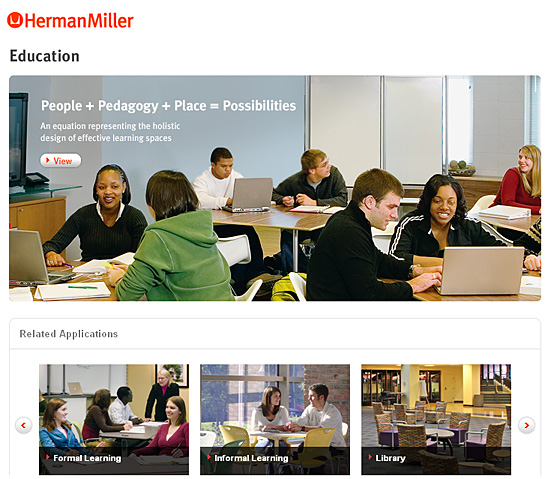Linking theory to experience: The Learning Studio Research Program
Presented by: Susan Whitmer, Herman Miller Inc. and Dr. Roger Yohe, Estrella Mountain Community College
Tuesday, May 11, 2010, 1:00 p.m. EST
What You’ll Learn:
With more than five billion assignable square feet of space on college and university campuses today, what proof is there that this vast inventory of learning space has any effect on the student learning experience? Join us for a conversation about the rigorous quantitative and qualitative research methods we’re using to understand the relationship between learning spaces and the student and faculty experience.
Also see:
Student Success in College: Creating Conditions That Matter
Preface.
PART ONE: INTRODUCTION.
1. Student Engagement: A Key to Student Success.
PART TWO: PROPERTIES AND CONDITIONS COMMON TO EDUCATIONALLY EFFECTIVE COLLEGES.
2. “Living” Mission and “Lived” Educational Philosophy.
3. An Unshakeable Focus on Student Learning.
4. Environments Adapted for Educational Enrichment.
5. Clear Pathways to Student Success.
6. An Improvement-Oriented Ethos.
7. Shared Responsibility for Educational Quality and Student Success.
PART THREE: EFFECTIVE PRACTICES USED AT DEEP COLLEGES AND UNIVERSITIES.
8. Academic Challenge.
9. Active and Collaborative Learning.
10. Student-Faculty Interaction.
11. Enriching Educational Experiences.
12. Supportive Campus Environment.
PART FOUR: SUMMARY AND RECOMMENDATIONS.
13. Principles for Promoting Student Success.
References.
Appendices.
Appendix A: Research Methods.
Appendix B: Project DEEP Research Team.
Appendix C: National Survey of Student Engagement.
Index.
| Course Information |
| Webinar Recording
Bibliography Barr, Robert B., and John Tagg. “From Teaching to Learning–A New Paradigm for Undergraduate Education.” Change 27. N6 (1995): 1225. Print. Bransford, John Douglas. How People Learn: Brain, Mind, Experience, and School. Washington, D.C.: National Academy, 2000. Print. Chickering, Arthur W., and Zelda F. Gamson. Seven Principles for Good Practice in Undergraduate Education. Publication. Washington: American Association for Higher Education, 1987. Print. Garcia, Linda L. Millennial Students’ and Faculty’s Perceptions of a New Generation of Learning Classrooms. Diss. University of Texas at Austin, 2007. Print. George, Gene, Tom Erwin, and Briony Barnes. “Learning Spaces as a Strategic Priority.” EDUCAUSE Quarterly. EDUCAUSE, 1 Nov. 2009. Web. 3 May 2010. Kuh, George D., Jillian Kinzie, John H. Schuh, Elizabeth J. Whitt, and &. Associates. Student Success in College: Creating Conditions That Matter. San Francisco: Jossey–Bass, 2005. Print. Rickes, Persis C. “Make Way for Millennials! How Today’s Students Are Shaping Higher Education Space.” Planning for Higher Education 37.2 (2009): 7–17. Print. Wabash National Study of Liberal Arts Education. Center of Inquiry: Wabash College. Wabash College. Web. 4 May 2010. |









